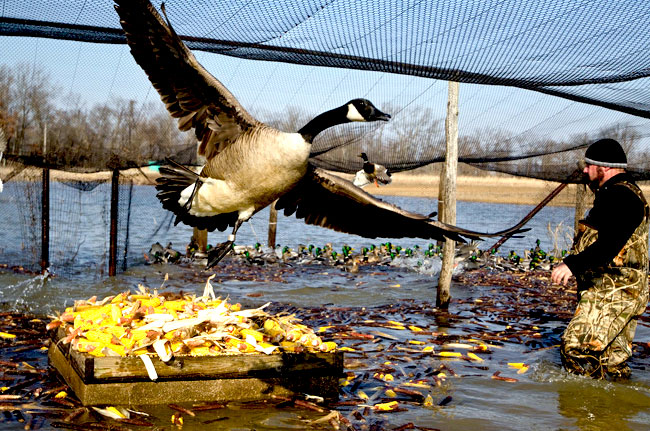Author Art Lander Jr.
Wildlife surveys have a simple goal – to gather information.
“They help biologists monitor non-game species, and effectively manage populations of the animals we hunt,” said David McChesney, federal aid program coordinator for the wildlife division of the Kentucky Department of Fish and Wildlife Resources. “This ensures the overall well-being and responsible stewardship of Kentucky’s wildlife.”

Revenues from license sales along with federal matching funds pay for a lion’s share of the costs related to conducting wildlife surveys.
In 1937, Congress passed the Federal Aid In Wildlife Restoration Act, commonly referred to as the Pittman-Robertson Act. This law established a pool of funds raised from a federal excise tax on the sale of firearms and ammunition (archery equipment was added in 1972). The funds are then allocated to state fish and wildlife agencies to assist them with wildlife research, restoration and management.
“Hunters and shooters are willing to pay more for their equipment, with the understanding they are benefiting scientific decision-making and conservation, and increasing recreational opportunities,” said McChesney.
Kentucky Fish and Wildlife biologists spend tens of thousands of hours in the field each year collecting data for over 70 wildlife surveys. Biologists collect data on game and non-game species, including: deer, elk, furbearers, threatened and endangered species, black bears, migratory birds, upland game, raptors, reptiles, amphibians and wild turkeys.
Surveys conducted by biologists cover the full range of issues critical to species monitoring and management. The surveys include population counts, food availability, habitat evaluation, wildlife condition (health), parasite infestations, population densities, nesting, reproductive success, DNA, mortality factors (including hunter harvest) and wildlife damage to property and agricultural crops.
Sometimes, annual surveys include surveillance of disease outbreaks such as white nose syndrome. This disease surfaced in Kentucky this year and can be deadly to bats.
“In the winter, we check about 100 caves to inventory three endangered species of bats, said Brooke Slack, bat biologist for Kentucky Fish and Wildlife.
“While we were there, we checked for white nose syndrome, a fungus that is easily seen on the non-fur parts.”
Later in the summer, staff and volunteers take part in an activity level survey, which is important to bat population monitoring. “In June and July we drive 30-mile routes in the country, recording ultrasonic noises made by bats,” Slack explained.
Outside funding and volunteers help power non-game population monitoring.
“We often rely on outside matches (to help fund surveys) and time donated from volunteers or non-governmental sources,” said Sunni Carr, non-game program coordinator for Kentucky Fish and Wildlife.
Many of the deer surveys conducted by Kentucky Fish and Wildlife biologists focus on deer population status. They evaluate deer age and growth, body condition and range evaluation. They also monitor issues related to herd size, health and their impact on habitat.
“A vast majority of survey information can’t stand on its own,” said Tina Brunjes, the department’s deer and elk program coordinator. “You need multiple years or sampling periods to make definitive statements about a population.”
It’s the biologist’s job to put the survey data in context.
“You just can’t go out one night and count the bucks, does and fawns during a spotlight survey and say that’s how many deer are in a given area,” said Brunjes.
Biologists who work with migratory birds are involved in about a dozen annual surveys, including some that require mandatory input from hunters.
“For continued participation in the conservation snow goose season, hunters must fill out a survey,” said Rocky Pritchert, migratory bird program coordinator for Kentucky Fish and Wildlife. “That helps us monitor harvest and keep up with strategies they are using to hunt the birds.”
Another example of a mandatory survey is the Hunter Information Program (HIP), in which migratory bird hunters must answer a few questions when they buy their license. A small percentage of these hunters are asked to participate in a more lengthy post-season survey.
“It’s a species specific sample for either waterfowl, doves or woodcock,” said Pritchert. “The data gives biologists a clear picture of hunter success, and the level of participation (hours spent afield), what they’re seeing, and how many birds they’re taking.”
Wood duck brood counts are a measure of reproductive success on a particular stream, offering biologists valuable population trend data. “Just as our aerial census (conducted periodically throughout the late fall and winter) is not a complete count of ducks and geese in Kentucky,” said Pritchert, “It’s a snapshot of a point in time of how many birds are on a particular site at a particular time.”
This differs from the spring goose survey, which Pritchert said is a true population estimate of resident geese conducted for the past 15 years.
Another example of a long running migratory bird survey is the banding of wood ducks and resident Canada geese. “Our target is to band 1,000 geese and about 2,000 wood ducks each year,” said Pritchert. “Band recovery provides us with data on annual survival and hunter harvest rates.”
Wildlife surveys help biologists manage both game and non-game species to their fullest potential. This information helps improve the quality of life for all Kentuckians.
-30-
June 23, 2011
To contact: Art Lander, Jr.
1-800-858-1549, ext. 4414
The Kentucky Department of Fish and Wildlife Resources manages, regulates, enforces and promotes responsible use of all fish and wildlife species, their habitats, public wildlife areas and waterways for the benefit of those resources and for public enjoyment. Kentucky Fish and Wildlife is an agency of the Tourism, Arts and Heritage Cabinet. For more information on the department, visit our website at fw.ky.gov.



Be the first to comment